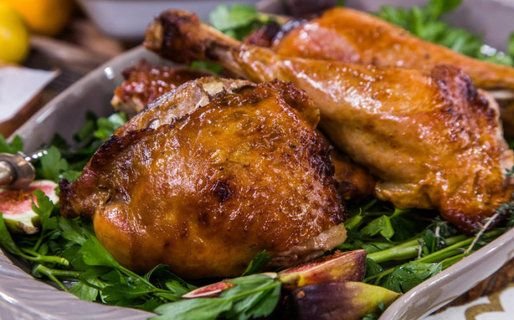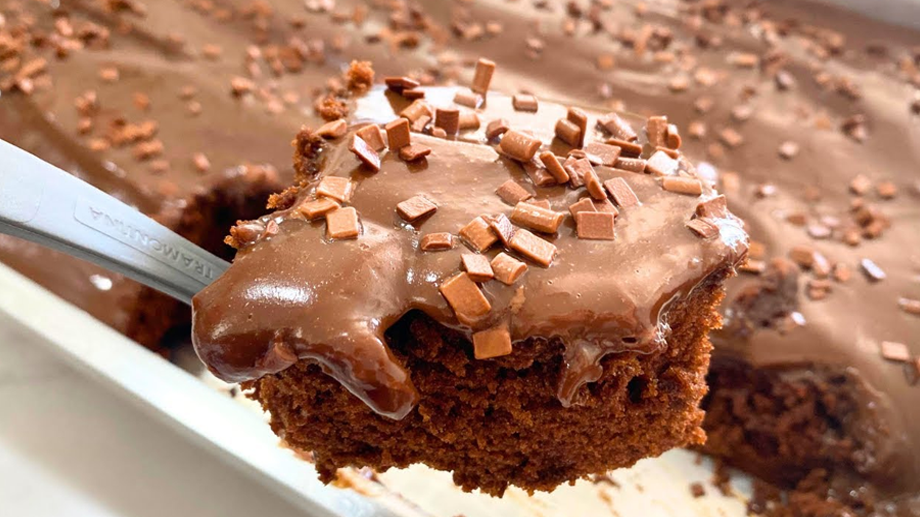
Follow our complete, step-by-step, instructions on how to Spatchcock a turkey, then roast it in the oven. This 14lb turkey cooked in one hour and ten minutes. Really. Crispy skin, moist all the way through, and ready in no time.
How To Spatchcock and Roast a Turkey
Yes Virginia, you really can cook a whole turkey in about an hour.
I was one of those that found it hard to believe also, so don’t feel bad. I feel your pain.
There’s no telling how many years I got up early on Thanksgiving morning to get a turkey in the oven. I’m sure you may have done so as well. It was almost like it was part of the tradition, something you had to do in order to have a turkey on the table by noon time.
Well, not any longer.
I roasted this almost 14 pound turkey in 1 hour and 10 minutes.
I’ve got a recipe for How To Roast A Turkey elsewhere here on Taste of Southern. This recipe pretty much follows the same procedure except this one requires that you remove the backbone and flatten it out before roasting.
With both recipes, I dry brine the turkey, rubbing it with Kosher Salt and placing it uncovered in the refrigerator overnight, or at least for 12 hours. This dry brine helps to dry out the skin so that it cooks up nicely browned and crispy.
The only difference between the two, is this one cooks much faster. Very much faster.
I know it has a funny name. Some folks also refer to it as a butterflied turkey. Either way, it works.
This process will work with a turkey of any size. Just be sure you have a very sharp knife or good poultry shears to cut out the backbone. That’s very important. And, make sure you know where your fingers are while you’re cutting.
I was really pleased with how quickly this turkey cooked and with how moist it was. By flattening out the bird, it cooks more evenly so you’re not over cooking the breast while waiting for the dark meat to get done. It’s a win win all the way around. I know you’re going to like it.
Ready to give it a try? Alright then, grab those poultry shears and head to the kitchen. Let’s Get Cooking!
Butterflied Turkey, you’ll need these ingredients.
These steps need to be done the day BEFORE you intend to roast your turkey.
Remove your turkey from it’s packaging, place it in your sink, then remove the neckbone.
If the giblets are included with your turkey, (some don’t include them) you will typically find the neckbone inside the cavity of the bird. Remove it and set it aside.
Remove the giblet packet.
This is generally packed inside the neck cavity of the bird. The giblets are usually all together in a sealed bag. Remove the bag and set it aside. We will be using the giblets to make Giblet Gravy later.
I always cut off the tail. You can leave it if you like, doesn’t really matter either way.
Did you know this part is often referred to as the “Popes nose,” or the “preachers nose”?
Don’t blame me, I didn’t make it up. It’s true though.
Next, we will cut out the backbone of the turkey. I’ve placed the two black lines on the photo above to better illustrate where you need to make the cuts.
This will be the most difficult part of the process. You need a really sharp boning knife or a really good pair of poultry shears to do this. You have a bone or two that you need to cut through, so use a lot of caution when you do this. Your fingers will thank you later. Smile.
I started at the tail end and cut up one side of the backbone.
I’m using kitchen shears, which I really didn’t know if they were good enough to do this with or not, but happily they performed great. Just always know where your fingers are before you make that cut.
There were a couple of times where I had to use both hands to complete a cut.
A few snips, grunts and two handed cuts later, I had made it through the one side of the backbone.
Turn the turkey around, and head back the other way on the other side of the backbone.
For this second cut, I’ll be starting from the neck and cutting back towards the tail.
I’ve mentioned this before, but I am right handed. Most all of my photos show me using my left hand, but that’s because I’m using the right hand to snap the photos with.
Again, do make sure you know where your fingers are at all times before you make a cut.
With both cuts complete, the backbone has been removed. Set this aside with the giblets for now. We can use this later to make stock or maybe we’ll just cook it with the giblets to add more flavor.
Congratulations, the hard part is complete. You done good. Smile.
Rinse the turkey under cold running water, on both the outside and the inside.
Now’s a good time to do any final trimming that might be needed. This is the skin from the neck that I will remove. I placed the knife so you could see where I’ll be cutting it. Right along where the cutting edge of the knife is.
Pat the inside and outside of the bird dry with paper towels.
Crack the breast bone.
This part will take two hands, but again, I’m taking photos. Just press down on the breast bone in the area where you see my hand here, and push hard. You’ll hear the bones crack when you do.
This will flatten the bird for more even cooking.
The turkey is now ready for the dry brine process.
Flip the bird over, and sprinkle some kosher salt and black pepper over the meat.
Just a light coat of salt is all that’s needed.
Sprinkle the skin side with salt and black pepper. It doesn’t take a lot, but be sure to get it on all the surface areas and down in between the breast and the thigh area.
I placed a small amount of kosher salt in a separate small container to make this job easier. Since I’ve been touching the turkey, then dipping into the salt, I’ll throw away the remaining salt once I’m finished. You don’t want to cross contaminate anything as you do this.
I went ahead and placed some slices of butter under the skin of the turkey.
I gently worked my fingers underneath the skin to loosen it from the breast meat. Then, I just placed some slices of butter underneath.
You could also use some type of herb butter, or add any additional herbs and spices you might like to add more flavor to the cooked bird.
That’s it, you’re done for now. That wasn’t too hard was it?
Place the turkey UNCOVERED on the bottom shelf of your refrigerator for at least 12 hours. Overnight is preferred. This will allow the salt to dry out the skin on the turkey which in turn will make for a much crispier skin once the turkey has been roasted.
I suggest that you not have any other uncovered foods in the refrigerator at this time. They should be wrapped if you do. You also want this on the bottom rack so there isn’t any chance of juices spilling down onto anything else.
Save those giblets and other pieces.
I placed all this in a plastic zip lock bag and put it in the refrigerator as well. I want to use the giblets to make gravy and will probably just freeze the other pieces to use to make stock with later.
You can find my recipe here for Giblet Gravy.
Remove the turkey from the refrigerator two hours before you plan to roast it.
Here’s my turkey after being in the refrigerator uncovered for 14 hours.
The dark meat is really showing through the skin at this point, and you can easily see the butter pieces that I placed under the skin.
I’ve elevated the bird on my OXO Silicone Racks, but it’s not really necessary.
The turkey needs to just sit out on your counter, still uncovered, for about an hour and a half unless it’s in the middle of summer where you live at the moment.
We’re going to let the turkey begin to come up to room temperature to aid in the cooking process.
Just figure out what time you want to serve the turkey, allowing about 30 minutes after it’s cooked for it to sit once again and rest. Once it’s cooked, it needs to rest a bit so the juices can redistribute themselves throughout the bird.
Brush the skin side with some melted butter before placing it in the oven.
I slightly melted about three Tablespoons of butter in the microwave, then brushed it all over the skin side of the turkey.
NOTE: If you think you applied a lot of salt to the skin, you can brush most of that away with a paper towel before you brush it down with butter. You don’t want the skin to be overly salty and ruin the taste of your turkey once it’s sliced.
FOLLOW THESE BAKING INSTRUCTIONS CAREFULLY.
Place the turkey in a oven preheated to 425F degrees.
Roast the turkey for 30 MINUTES at 425F degrees.
REDUCE the temperature to 325F degrees, cook turkey until done.
You’ll find many variations regarding the temperature that turkey needs to be cooked before it’s done.
Some say the temperature in the thigh needs to reach 185F degrees, and the breast meat needs to be cooked until it reaches 165F degrees.
I’ll go along with those temperatures.
One of the problems when trying to roast a whole turkey is that the darker meat takes longer to cook than the white meat. Thus, the white meat will overcook and begin to dry out while you wait for the thigh meat to come up to temp.
With this spatchcock method, the turkey lies flat on the pan, and it cooks more evenly. The thighs cook quicker this way so the breast meat doesn’t have time to dry out.
I suggest you always use a digital thermometer to check the temperature with. You can find them for 10.00 or less at lots of big box type stores. Insert the thermometer into the thickest part of the thigh, being sure not to touch the bone, and check the temperature at that point. Check several points around the thighs and breast to be sure it’s done all the way through.
Once it’s done, remove the turkey from the oven and place the pan on a wire rack to cool. Lightly cover the turkey with a sheet of aluminum foil and let it rest for at least 30 minutes prior to slicing.
Don’t forget to save the pan drippings. We will use them to make our Giblet Gravy.
Enjoy!
It really did cook to perfection in an hour and ten minutes. Gotta love that… right?



